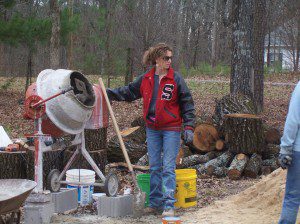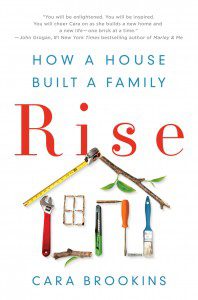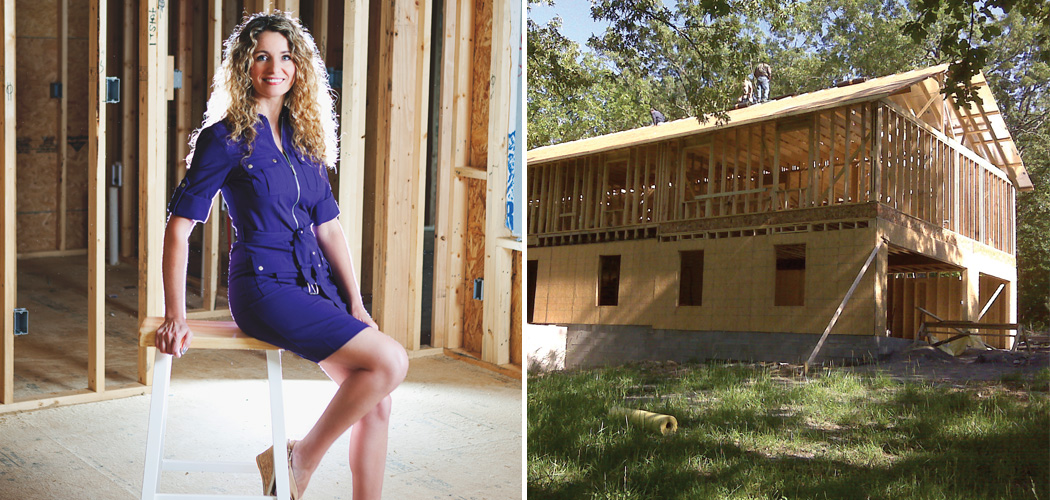[title subtitle=”words: Heather Steadham
Image: courtesy Cara Brookins”][/title]
This may be the first time you’ve heard of Cara Brookins, but you can be certain it won’t be the last. With eight novels already published, more than a quarter of a million Twitter followers, and her latest book, a memoir titled Rise: How a House Built a Family, selling to St. Martin’s Press for six figures, she’s sure to be a household name sooner than later.
Cara didn’t always know the writing life was for her. More than fifteen years ago, she was studying psychology at Harding University in Searcy, Arkansas. But after escaping with three kids from an abusive marriage, Cara had an epiphany. “One day I decided, you know what?” Cara says, her blond, curly hair framing her petite face and her mega-watt smile positively sparkling. “I really don’t want to do this!”
Instead, she took a job with the City of Little Rock as a computer programmer in January of 2001, a decision that made total sense to her at the time. “Computers do what you tell them to,” she explains. “They’re totally logical. How cool is that?” And for the last fifteen years, she’s been writing code for the state’s capital by day and working hard as an author by night.
While writing had never been Cara’s vocation, she’d been telling stories ever since she was a little girl. Growing up in the country in Wisconsin, Cara would play make-believe with her brother and narrate their adventures, but would never write those stories down because she had (and still has) “atrocious and embarrassing handwriting” as well as difficulties with spelling. But once word processing programs became prolific on the very computers she worked with day in and day out, Cara no longer had an excuse to put off writing down the tales that had been swirling in her head since her childhood days.
So what to write first? When she was growing up, Cara asked her parents over and over again to tell her stories about their childhoods. She was especially drawn to her grandmother’s tales of surviving the Great Depression. “But her history was sort of ugly,” Cara explains. “Way back then, her parents were divorced, and her mom had an affair with this bum who taught them to bootleg liquor—that’s how they really got through the Depression. But I wanted to tell my kids these stories about how to survive, and I wanted to tell it all clean and wholesome.” So clean it up she did, and Doris Free, a historical novel based on Cara’s grandmother, was born. It was Cara’s first attempt at writing anything at all.
But here’s where Cara’s story becomes stranger than fiction: Having no experience whatsoever in publishing, Cara was clueless about how to properly seek a publication outlet for her new venture. While most authors go through a time-consuming and heartbreaking process of seeking an agent with hopes of one day securing a book deal in a publishing landscape where the odds are seriously stacked against them, Cara just picked a book off her bookshelf, wrote the address on an envelope, and sent her manuscript straight to a publisher.
Luckily for Cara, her way of approaching things worked just fine. “They called me, like, ‘Hey we like your book! We’d like to buy it. Here’s the royalty rate.’ I was like, ‘Oh, that sounds great.’ I didn’t even celebrate like I should’ve because I didn’t know it was supposed to be hard. I just thought Oh, okay. I’ll write another one. If I’d known going in the process you were supposed to go through, and the high rate of failure, I never in my life would’ve written a book and sent it in. Never. I would’ve been too afraid of that. If it wouldn’t have been for that accidental success, I don’t know if I’d ever have written a book.”
 Thank goodness she did. And she didn’t stop. Soon came Gadget Geeks, another children’s book, this one a modern story of two unlikely friends and their robot, as well as a second Doris Free book. Cara began seeking out other authors to connect to and conferences to attend so she could improve her craft as well as network in the wide world of publishing. But it’s Cara’s outgoing personality, her endless reserve of ideas, and her amazing ability to seize opportunities that elevate her natural writing ability to true star potential. One time, while at the Oklahoma Writers Federation Conference, Cara was in line to pitch her newest project, Little Boy Blu, a thriller about a reality show featuring an Appalachian family with a genetic abnormality that causes blue skin. But the line was long, and at another table, Cara saw a different publisher sitting with no wait at all. “What are you looking for?” she asked the publisher.
Thank goodness she did. And she didn’t stop. Soon came Gadget Geeks, another children’s book, this one a modern story of two unlikely friends and their robot, as well as a second Doris Free book. Cara began seeking out other authors to connect to and conferences to attend so she could improve her craft as well as network in the wide world of publishing. But it’s Cara’s outgoing personality, her endless reserve of ideas, and her amazing ability to seize opportunities that elevate her natural writing ability to true star potential. One time, while at the Oklahoma Writers Federation Conference, Cara was in line to pitch her newest project, Little Boy Blu, a thriller about a reality show featuring an Appalachian family with a genetic abnormality that causes blue skin. But the line was long, and at another table, Cara saw a different publisher sitting with no wait at all. “What are you looking for?” she asked the publisher.
“Young adult,” the publisher answered. “Got anything?”
She did, sort of. For several years, Cara had shelved a project—a young adult series about a teenage boy who travels through time to ensure the survival of the human race. Cara couldn’t even remember how old the protagonist in Timeshifters was or what his last name was, but by gosh she charmed the publisher and Buzz Books published a trilogy of the young adult action series.
She ended up selling the thriller eventually, too.
 But there was one story that Cara never thought she’d publish—her own. Having gone through difficult marriages, Cara looked to process her life story the way she had processed her grandmother’s: through fictionalizing the experience.
But there was one story that Cara never thought she’d publish—her own. Having gone through difficult marriages, Cara looked to process her life story the way she had processed her grandmother’s: through fictionalizing the experience.
At first, in order to tell the story but lessen the pain, Cara changed all the names and wrote her story as a novel. Her mentor, David Morrell (best known for the Rambo series), liked the book so much he referred her to his agent, who immediately wanted to sign her—and wanted her to rewrite it as a memoir. “No!” Cara responded. “David said this was okay.” And it was okay, the agent assured Cara. She told her it was a perfectly fine story written as fiction, and that Cara would still be able to talk about domestic violence and make some sort of impact. But, the agent pointed out, wasn’t the whole point to be truthful? And didn’t Cara want other women to be truthful about domestic violence as well?
It was a point Cara couldn’t argue. She rewrote the book as a memoir, telling the story of how she and her children built Inkwell Manor, their 3,500-square-foot-home, from the ground up after leaving the damaging relationships, and ultimately rebuilt their family after years of trauma.
You don’t have to go further than Eat, Pray, Love by Elizabeth Gilbert or Wild by Cheryl Strayed to see how memoirs can resonate so effectively that they become cultural phenomena. But with Rise: How a House Built a Family, Cara’s got something different—something that so many can relate to on an even deeper level: a family accompanying her on her journey. “The reality is that most of us don’t go through trauma all alone,” Cara explains. “Most of us have kids. So how do you pull a family through? You have to find something that you can all do together. It doesn’t have to be building a house, but in my opinion, it has to be something that you see as impossible. Something that is so big it changes the way you see yourself. That you are so determined, and you will accomplish it, and then you’ll never see yourself that same way again. You change the person you are. Your perception of yourself, and each other.”
 Rise: How a House Built a Family will be released by St. Martin’s Press on January 24, 2017. Preorders are available online now through Amazon, Barnes & Noble, Books-A-Million, and IndieBound.
Rise: How a House Built a Family will be released by St. Martin’s Press on January 24, 2017. Preorders are available online now through Amazon, Barnes & Noble, Books-A-Million, and IndieBound.




